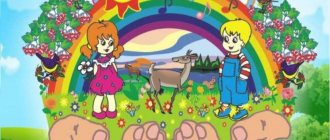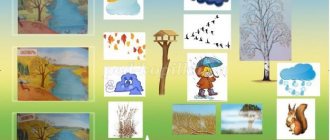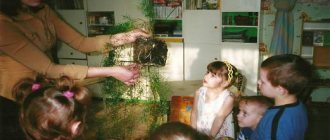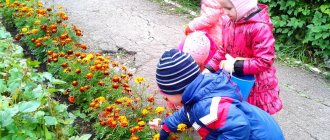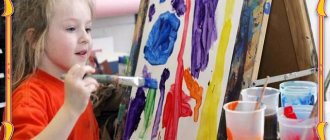Speech “Environmental education of preschool children”
The main goal of environmental education is the formation of the child’s correct attitude towards the nature around him, towards himself as a part of nature. Love for nature, a conscious, careful and interested attitude towards it, must be cultivated from early childhood, therefore I pay great attention to environmental education. I have identified the following tasks:
— To form in preschoolers a conscious attitude towards nature, its phenomena and objects;
— Improve the ability and skills of observing living and inanimate objects of nature;
— To develop environmental thinking and creative imagination in the process of experimental and research activities of children;
— To educate elementary standards of behavior in relation to the natural world and the surrounding world as a whole.
In my opinion, ecology can be integrated into all types of activities of a preschooler.
The use of fiction in combination with small forms of folklore evokes a range of feelings in children - emotion, admiration, tenderness, delight. They instill in children a belief in the weight and significance of words.
To help children in an entertaining way identify the features of natural phenomena, seasonal changes in nature, determine the qualities of an object, the habits of animals, I use riddles, poems, proverbs, sayings, and nursery rhymes. In nursery rhymes, all the phenomena and forces of nature come to life: the sun, rainbow, thunder, rain, wind, seasons live as animated beings. Children seem to come into contact with them themselves: they ask the sun for warmth and affection:
"Shine, shine, sunshine,
To the green pole,
For white wheat
For clean water.
To our little garden,
On a scarlet flower."
An important source of knowledge about nature is observation. One of the goals of my work is to improve children's skills in observing living and inanimate objects of nature. In the process of observation, children learn to peer, admire, rejoice and admire the beauty of nature; they develop observation and curiosity, a kind, caring attitude towards natural objects. Observation makes it possible to introduce children to natural phenomena and the relationship between living and inanimate nature. I organize observations with children when introducing children to plants and animals, the weather, the work of adults in nature, during classes and excursions, on walks, in a corner of nature, etc.
In my work on environmental education I use various traditional and non-traditional forms, methods and techniques, taking into account the age and individual characteristics of children. To expand children's ideas about nature, to deepen children's knowledge, I use ICT. They, due to their clarity, colorfulness and simplicity, allow me to more effectively build the process of learning new concepts for children of generalization and systematization of knowledge.
To successfully implement the assigned tasks, I have developed:
— A set of educational integrated classes using ICT.
— A long-term plan for the work of educational activities with children of all age groups has been developed.
— An experimentation corner has been set up (experiments, experiments, observations)
— A card index has been created, including a selection of environmental games, physical education lessons, riddles and poems about nature, presentations, and songs.
— A mini library of children's literature and encyclopedias has been created.
One of the most effective and most interesting means of environmental education for children is games. I use environmental games primarily for the purpose of clarifying, consolidating, generalizing, and systematizing knowledge. While playing, children better acquire knowledge about objects and natural phenomena, learn to establish relationships between them and the environment, learn about ways of adaptation of living beings to the conditions of their habitats, about the sequential change of seasons and about changes in living and inanimate nature. Great opportunities for developing environmental feelings in relation to the world around us lie, first of all, in didactic games.
Didactic games are a multifaceted and complex phenomenon. This is a method and form of education, an independent play activity, and a means of comprehensive personality education. I use didactic games not only in children’s free activities, but also include them in classes, targeted walks, as well as in experimental activities of students. Games with various natural materials (vegetables, fruits, flowers, stones, seeds, dry fruits) are very effective, which bring children as close as possible to nature, and always arouse keen interest and an active desire in children to play. For example: “Children on the branches”, “Tops and roots”, “Which tree is the leaf from”, “Wonderful bag”, “Guess what you ate”, “Find the same plant in the bouquet”, etc. Special joy and Children are interested in outdoor games of a natural history nature, which are associated with imitation of the habits of animals, their way of life: “Little Frogs and a Heron”, “Mice and a Cat”, some games reflect the phenomena of inanimate nature: “Droplets”, “Sun and Rain”, "Cheerful breeze." The joy gained in the game helps to deepen children's interest in nature and the development of physical qualities.
In my work I use experimental research activities. Children are born explorers. And this is confirmed by their curiosity, constant desire to experiment, and desire to independently find a solution to a problem situation. My task is not to suppress this activity, but, on the contrary, to actively encourage it. I include experimental research activities in games and activities; it can be associated with children’s work in a corner of nature and in the garden.
First of all, a corner of nature where indoor plants are kept helps to introduce children to nature and cultivate a love for it. Children see plants in this corner of nature every day; under my leadership, children systematically observe and care for them. Working in a corner of nature has great educational value. Children develop a caring, caring attitude towards nature and develop a responsible attitude towards their responsibilities. In the process of care, children gain an understanding of the diversity of the plant world, how plants grow and develop, and what conditions need to be created for them. She also created a corner of nature, where there are natural materials, visual aids, educational games, card indexes of riddles about animals and plants, observations in nature, artistic expression, physical education lessons, finger games, a nature calendar (children regularly record the weather and the state of wildlife by inserting pictures with natural phenomena observed on the street), “garden on the window.”
The most effective way to implement the tasks of environmental education is to organize project activities. I have developed an environmental project “Young Nature Defenders”, “Let’s Help the Birds in Winter”, “Amazing Insects”, “Harm and Benefit from Nature”, “Love and Know Your Land”.
The general objectives of these projects were:
· developing in children and parents a sense of belonging to all living things, a humane attitude towards the environment and the desire to show concern for the conservation of nature.
· create an environmentally friendly environment on the territory of the preschool educational institution for the implementation of priority areas;
· to generate knowledge about the ecosystem organization of the Earth’s nature within the boundaries of human habitation;
· develop the cognitive skills of children and parents when mastering research methods of understanding nature;
· organize practical environmental activities of children and parents;
· implement one of the forms of working with parents in the design and research activity “My Family’s Ecological Trail”;
· develop mutual understanding and mutual assistance between children, teachers, parents, the need for constant self-development of environmental culture;
· develop initial geographical understanding, familiarity with the simplest methods of orienteering;
· educate children to have an attentive, reasonable, and caring attitude towards the natural environment.
The novelty of environmental projects lies in the use of information and computer technologies. The main fact that ensures the effectiveness of the educational process is the personal involvement of children and parents. By using new technologies that are exciting for a new generation, this inclusion can be ensured. Projects allow children and parents to participate in environmental campaigns and landscaping. Working on environmental projects is a unique opportunity for children and parents to express themselves and benefit the surrounding nature of their native land.
Expected project results:
— creation of an environmentally friendly environment on the territory of the preschool educational institution;
— increasing the level of knowledge on ecology in children;
— improving the level of knowledge and environmental competence of parents on the topic of the project.
The experience of my work has shown that purposeful, systematic work on environmental education of preschool children, in an interesting, entertaining form, helps children see all the beauty of nature, reveal all its secrets and laws, instill in children kindness, a responsible attitude towards the world around them, the people who live near.
Report to the teachers' council "Environmental education of preschool children"
Marina Borisova
Report to the teachers' council "Environmental education of preschool children"
Content.
1. Introduction.
2. Environmental education of preschool children.
3. Methods and techniques of environmental education of preschool children.
“A man became a man when he heard the whisper of leaves and the song of a grasshopper, the murmur of a spring stream and the ringing of silver bells in the bottomless summer sky, the rustle of snowflakes and the howling of a blizzard outside the window, the gentle splash of a wave and the solemn silence of the night - he heard, and, holding his breath, listens hundreds and thousands of years of wonderful music of life.”
V. A. Sukhomlinsky.
1. Introduction.
The ecological state of our planet and the trend of its deterioration require that living people understand the current situation and have a conscious attitude towards it. Environmental problems are common to all continents and states. There are them in Russia too - each region has its own.
Russians know firsthand about the progressive deterioration in the health of adults and children. As a result of soil, water and air pollution, people eat poor-quality foods, drink bad water, and breathe air with a large admixture of exhaust gases.
Environmental problems and the need to overcome them have given rise to a new direction in education – environmental . It is important for each of us to understand how a person is connected with nature and how he depends on it, what patterns exist in nature and why humanity has no right to ignore them.
Ecology emerged as a special branch of science in the 19th century. At that time, it was only a part of zoology and examined the relationships of animals, communities with each other and with the environment. ecology itself was introduced by the German naturalist Ernst Haeckel. It was defined as the science of the relationships of living organisms with the environment and with each other. Translated from Greek, “ ecology” is the science of home, dwelling (“oikos” - house, “logos” - science). Now this direction is called biological, or classical, ecology. Of course, ecology is not an easy science. But in order to understand it and meaningfully work in the field of environmental education , you first need to remember four laws, formulated in popular form by the American scientist Barry Commoner:
• everything is connected to everything;
• everything disappears somewhere;
• everything is worth something (nothing is given for free);
• nature knows best.
In preschool childhood, the child acquires the foundations of personal culture, its basis, corresponding to universal spiritual values. The basis of personal culture includes the child’s orientation in four main spheres of reality - nature, objects created by human hands, phenomena of social life, and activity in oneself. At preschool age, mastering the basics of environmental knowledge is most promising, since it is at this age that the child perceives nature very emotionally and pays attention to features of nature that an adult would not even notice. A child is able to be surprised by what surrounds him and asks a lot of questions about plants and animals. He perceives animals as equals, sympathizes with them, and empathizes with them. It is this opportunity that should be used as fully as possible for the purposes of environmental education.
2. Environmental education of preschool children.
The authors of various programs and manuals offer various formulations of the goals and objectives of environmental education of preschool children: “education of the principles of ecological culture” (S. N. Nikolaeva, “formation of a certain level of conscious attitude, expressed in behavior, attitude towards nature, people, oneself, place in life "(N.A. Solomonova, education of a responsible attitude towards nature (A.V. Koroleva, education in a child’s need to preserve and improve nature, development of his creative potential (N.E. Orlikhina, “formation in children of a consciousness corresponding to this problem”) (G. Filippova) E. F. Terentyeva suggests that “ecological education of preschool children can be considered as a process of forming a consciously correct attitude towards the environment .” S. N. Nikolaeva believes that the formation of the principles of environmental culture is “the formation of a conscious - a correct attitude towards nature in all its diversity, towards people who protect and create material and spiritual values on the basis of its wealth.”
The goal of environmental education is the formation of a new type of person with new ecological thinking, capable of realizing the consequences of his actions in relation to the environment and able to live in relative harmony with nature. Already at an older age, children without much effort acquire a complex of environmental knowledge if the knowledge is presented in an accessible, exciting form and if the child’s interest in natural phenomena is taken into account.
To achieve this goal, it is necessary to solve a number of interrelated problems in the field of education, upbringing and development of the child :
• formation of a system of elementary scientific environmental knowledge that is understandable to a preschool child (primarily as a means of developing a consciously correct attitude towards nature);
• development of cognitive interest in the natural world;
• formation of initial skills and habits of environmentally literate behavior that is safe for nature and for the child himself;
• fostering a humane, emotionally positive, careful, caring attitude towards the natural world and the environment in general; developing a sense of empathy for natural objects;
• formation of skills and abilities to observe natural objects and phenomena;
• formation of an initial system of value orientations (perception of oneself as a part of nature, the relationship between man and nature, the intrinsic value and diversity of meanings of nature, the value of communication with nature);
• mastering basic norms of behavior in relation to nature, developing skills for rational environmental management in everyday life;
• developing the ability and desire to preserve nature and, if necessary, provide assistance to it (care for living objects, as well as skills in basic environmental activities in the immediate environment;
• formation of basic skills to foresee the consequences of some of their actions in relation to the environment.
Any education, be it environmental , aesthetic, moral, must be an education of the heart, which gives rise to feelings, thoughts and actions. All the great teachers of the world talk about this. The heart is the source of humanity in man. “The years of childhood are, first of all, the education of the heart,” wrote V. Sukhomlinsky. Environmental education of preschool children without education of the heart is impossible . And the time limit for this is short - seven years; it will be extremely difficult to do this further.
One of the tasks of environmental education is to form in the child an idea of man not as a master, a conqueror of nature, but as a part of nature that depends on it. It is necessary to eradicate the consumer attitude towards nature. Currently, most preschool children have formed a clear division of animals into bad and good, evil and kind, harmful and useful. Many works of art and cartoons also contribute to this. In many of them, predators are depicted as evil, bad. They want to eat “good” hares, piglets, etc. As a rule, hares defeat wolves and are left to live in the forest alone, without evil predators. Many children are convinced that a predatory animal is bad, it is not needed in nature, and that the most beautiful forest is a forest without wolves. From an environmental point of view, in nature there are no bad and good, harmful and useful. Every animal and plant does its job, plays its role in nature. Everyone is needed equally - both wolves and hares. A forest without predators will not be a balanced ecosystem and will eventually begin to degrade. Consequently, one of the important tasks of environmental education is to develop an equally caring attitude towards all living organisms, regardless of whether we like them or not.
The subject environment of a preschool child includes various natural objects, so his familiarization with plants, animals, and inanimate natural phenomena is a natural process of learning about the world around him and acquiring social experience. This process, which takes place under the deliberate guidance of adults, may have different scientific basis.
An ecological worldview is a product of education; its formation occurs gradually over many years of a person’s life and teaching. The beginning of this process falls on the period of preschool childhood, when the first foundations of world understanding and practical interaction with the subject-natural environment are laid.
Environmental education of preschoolers is an introduction to nature for children, which is based on an ecological approach, and the pedagogical process is based on the fundamental ideas and concepts of ecology . Human interaction with nature is an extremely pressing problem of our time. At any time of the year, an observant person, walking through a field or forest and studying the tracks of an animal, will see how interesting the world around him is changing. The swamp becomes the scene of many events and incidents, and the overgrown bend contains an entire underwater world.
Rivers, meadows, forests with a variety of plants and animals are our wealth. It must be protected.
It is known that the use of natural resources should be approached with extreme caution. It takes a little time to cut down the thickest tree, but it takes many decades to grow it. There is nothing easier than catching a fish during spawning: at this time it loses all caution. But at the same time, her numerous offspring also die. If you destroy a bird's nest, the birds will not fly into it the next summer, and without them the surrounding forests and groves will begin to wither away.
It is necessary to educate children to care about their native nature and its riches. Arousing sympathy for plants and animals by revealing their properties, habits, and essence is one of the ways to cultivate a good attitude towards them. The child should not only realize that it is forbidden to destroy anthills, kill frogs and ruin bird nests, trample and tear flowers, but also experience love for the ant, frog, flowers and trees - for everything that surrounds him.
Children themselves need kindness and affection. And at the same time, they are able to selflessly and immeasurably give their kindness to all living things. We just need to help them preserve it for life. This will form the foundations of environmental culture in children.
3. Methods and techniques for environmental education of preschool children.
Among the various methods of environmental education of preschool children, an important place should be given to observation. Its essence lies in the sensory knowledge of natural objects, in their knowledge through various forms of perception - visual, auditory, tactile, olfactory, etc.
Prominent Russian psychologist S. L. Rubinstein considers observations as the result of meaningful perception, during which the development of mental activity occurs. From a young age, my children and I have been constantly observing changes in nature: the sun and the rain, the cat and the dog, the sparrow and the crow, the raindrops on the glass... And at an older age we observe how the color of the sky changes in different weather, how diverse the clouds are in their shape, animals, insects, birds, and phenomena of inanimate nature. We compare trees, shrubs (the time of change in leaf color, the appearance of buds, birds with each other (appearance, habits, wintering, migratory, migratory). Observations, walks, excursions give children food for thought. They have a lot of “Why?” and “ For what?".
Preschoolers’ knowledge of the surrounding world and natural phenomena is possible not only through observations; modeling activities can be of great help in this. A model is an objective, graphic or effective representation of something. You can create and use a wide variety of models with preschoolers. We use:
Calendar of observations of seasonal changes in nature;
Calendars of observations of plant growth and development;
Bird watching calendar.
In the life of preschool children, play is a leading activity. It represents an emotional activity: the playing child is in a good mood, he is active and friendly. A game as a method of environmental education is a game specially organized by the teacher and introduced into the process of learning about nature and interacting with it. In the game, the child is given the opportunity to solve many problems without fatigue, overstrain, or emotional breakdowns. Everything happens easily. Naturally, with pleasure, and most importantly, in a situation of heightened interest and joyful excitement. A fairly serious problem for preschool children is learning the rules of behavior in nature, as well as such moral norms as responsibility, selfless help, compassion, and these norms and rules are best learned through play activities. Children willingly play such educational games as “What is the name of your tree”, “Find a tree by seeds”, “What is good and what is bad”, “What kind of birds”, “Guess what kind of plant”, “The fourth odd one” , “Magic Screen”, “Traveling the Globe”, “Couples” and others. They enjoy learning the outdoor games “Owl - Owl”, “Migration of Birds”, “Geese - Swans”, “The Sea is Worried Once” and others.
Ecological activities, as one of the forms of organizing children's education, have their own very specific and very important function. A variety of work with preschoolers in everyday life allows them to accumulate specific ideas about the nature of their immediate environment. Classes as a special form of education contribute to the fact that the sensory ideas of preschoolers can be qualitatively transformed - expanded, deepened, combined, systematized. Children gain a lot of knowledge about nature during organized educational activities. In classes, children establish ecological connections that exist in nature. Without this knowledge, it is difficult to foresee the possible consequences of intervention in natural processes. Modern ecology can be defined as the science of the interrelations of living systems at various levels with the environment, of the interaction between man and nature. Without revealing these connections, full-fledged environmental education is impossible. Using some natural objects, I show that nature cannot do without them: what will happen if there are no mosquitoes. A child can learn basic environmental concepts Classes can be conducted using fairy-tale characters, but based on scientific data. For example, the fairy-tale Lesovichok helped us conduct classes on the topic “Forest”, and on the topic “Lake” - a merman and a Mermaid.
We often use fiction in our classes. Fiction about nature has a deep impact on children's feelings. (You must use literature recommended by the kindergarten curriculum.) These are works by A. Pushkin, F. Tyutchev, A. Fet, N. Nekrasov, K. Ushinsky, L. Tolstoy, M. Prishvin, V. Bianki, N. Sladkov and others. After reading, I have a conversation with the children and ask questions. You can see in their eyes sympathy, empathy or joy, delight. It’s very nice when children ask questions where they show care and love for our little friends: “Will someone save him?”, “Won’t they freeze?”, “Why didn’t anyone help him?” In these cases, it is important to convey to children the meaning of the work. We also use children’s desire for imagination. Skillful presentation of works of children's literature, development of environmental content for traditional games, excursions, compilation of fairy tales, stories, observations in nature, and in residential areas, winter gardens - all these forms make it possible to introduce children to many environmental laws. For classes we use visual aids: these are pictures about nature, albums, works of art, collections of stones, plant seeds, a herbarium, and gaming material. You cannot collect collections of butterflies and beetles, as this contradicts the principles of environmental education. The issue of environmental pollution has become very acute. Children excitedly discuss this topic, condemn those who are the culprits, and notice the wrong behavior of those around them.
We carry out environmental education in close connection with the family. Parents provide us with all possible assistance in the environmental education of their children (download information and documentaries about animals from the Internet, illustrations, make bird feeders with their children, bring flower seeds, help plant flower beds). Already at the first parent meeting “Child and Nature” We, together with parents, set the following tasks:
1) teach children to treat flowers, trees, shrubs and all living things with care;
2) take care of birds and animals;
3) teach children to see the beauty of the surrounding nature.
A survey of parents on the topic “What is ecology and is it necessary to study it” showed that adults are concerned about the environmental situation in the world. Another form of working with families is pedagogical screens, in which we give parents clear, specific, practical advice on a narrow topic. Through screens we introduce children and parents to folk signs, but always with the task: why do they say that? We organize consultations where I explain what needs to be told and shown to children, how to collect bouquets of autumn leaves. Every spring, our kindergarten holds a cleanup day, where teachers and parents dig up bushes, trim branches, plant flowers, and children help adults by collecting cut branches and last year’s fallen leaves. I advise parents to go with their children to the forest at different times of the year (in spring - look at the first spring flowers and twigs, listen to birdsong, in summer - watch the vibrant life of insects, in autumn - admire the beauty of autumn trees, in winter - admire the beauty of the winter landscape.)

